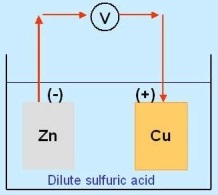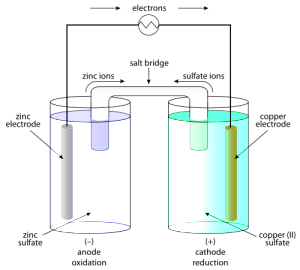A simple cell is a device that converts chemical energy into electrical energy. A simple electric cell consists of two electrodes (two different metals) and an electrolyte solution (acid or alkali solution or salt solution)
How simple electric cells work:
- The electrodes are made of two different metals
- The more reactive (electropositive) metal tends to undergo oxidation and gives up electrons readily. It will become the anode (negative electrode).
- The less reactive metal will become the cathode (positive electrode), as it has a weaker tendency to lose electrons.
- The cell voltage depends on the positions of the metals in the reactivity series. The further apart the metals are in the reactivity series, the bigger the voltage of the cell.
Example Of A Simple Electric Cell
Since zinc is more reactive than copper, oxidation will occur at the zinc electrode. Zinc will become the anode. Each zinc atom loses two electrons and is oxidised to a zinc ion. Zinc dissolves into the acid solution.
Anode reaction: $\text{Zn}(\text{s}) \rightarrow \text{Zn}^{2+} (\text{aq}) + 2\text{e}^{-}$
Electrons will flow through the external wire to the copper metal. Hence, copper will become the cathode as reduction will occur at the copper electrode. Hydrogen ion from the acid solution will receive the electrons. Each hydrogen ion receives one electron and is reduced to hydrogen. Bubbles of hydrogen gas are formed at the copper surface.
Cathode reaction: $2 \text{H}^{+} (\text{aq}) + 2 \text{e}^{-} \rightarrow \text{H}_{2} (\text{g})$
Overall reaction: $\text{Zn} (\text{s}) + 2 \text{H}^{+} (\text{aq}) \rightarrow \text{Zn}^{2+} (\text{aq}) + \text{H}_{2} (\text{g})$
Note that this reaction converts chemical energy into electrical energy.
Second Example Of A Simple Electric Cell
In this simple electric cell, two different metals and two different electrolyte solutions are used. Due to the usage of two different electrolyte solution, the end result will be different from the case above.
Since zinc is more electropositive than copper, zinc will become the anode. Each zinc atom loses two electrons and is oxidised to a zinc ion. Zinc dissolves into the acid solution.
Anode reaction: $\text{Zn}(\text{s}) \rightarrow \text{Zn}^{2+} (\text{aq}) + 2\text{e}^{-}$
Electrons flow through the external circuit to the copper electrode.
Copper will become the cathode. Each copper (II) ion from the electrolyte solution receives two electrons and is reduced to a copper atom.
Cathode reaction: $\text{Cu}^{2+} (\text{aq}) + 2\text{e}^{-} \rightarrow \text{Cu} (\text{s})$
Pink copper solid is deposited on the cathode. Concentration of copper (II) ions decreases. The blue solution (copper (II) sulphate solution) gradually turns colourless.
Overall reaction: $\text{Zn} (\text{s}) + \text{Cu}^{2+} (\text{aq}) \rightarrow \text{Zn}^{2+} (\text{aq}) + \text{Cu} (\text{s})$


Is there any foults in the operation of the simple cell
Topic: cells and batteries
Q1. What would be the possible effect in the cell if two identical strips were used as electrodes?
Q2. Briefly explain the properties of the electrolyte that enables the current to flow?
Thank you and your help is muchly appreciated if anyone could just answer my two questions as mentioned above.
Hi,
Thanks for the simple explanation, it was really well said.
I just have one question:
Why, in the simple cell with one beaker, do the electrons flow through the wire in the first place?
Couldn’t the redox reaction occur between the Zn(s) and the Sulfuric Acid to create Zinc Sulfate and Hydrogen gas at the metal? As in, the electron transfer occurs where the Zinc and acid touch?
Like why do the electrons travel through the wire when they can be tranferred more efficiently?
I can see why this isn’t a problem in the cell with the salt bridge, though, as the solutions are separated.
Thanks very much.
thanks for the help though I was a little confused at first concerning :anode (negatively charged) and cathode (positively charged) .
but now i think am catching up.
So what are the differences between a simple cell and an electrical cell?
In the above explanation. There is a mistake in assigning signs to the anode and cathode. If anyone has any problem in remembering the charge they can learn this truck to remember.
PAO – positive anode oxidation
NCR- negative cathode reduction.
This means that at anode you are saying oxidation is taking place however at oxidation loss of electrons are happening but at the same time you are assigning negative charge to anode.
That is the only mistake.
Umm I think there is a little mistake here. the negative electrode is called cathode, and the positive one is called anode.
Quote :
The more reactive (electropositive) metal tends to undergo oxidation and gives up electrons readily. It will become the anode (negative electrode).
The less reactive metal will become the cathode (positive electrode), as it has a weaker tendency to lose electrons.
Hi Ereick,
The anode is the electrode where the oxidation reaction
$$\text{Red} \rightarrow \text{Ox} + e^{-}$$
takes place while the cathode is the electrode where the reduction reaction
$$\text{Ox} + e^{-} \rightarrow \text{Red}$$
takes place. That’s how cathode and anode are defined.
In an electric cell, the negative electrode undergo oxidation and hence, it is termed as the anode.
Hope this clarifies.
Thats exactly what I was told. That the negative electrode is the cathode and the positive electrode is the anode…